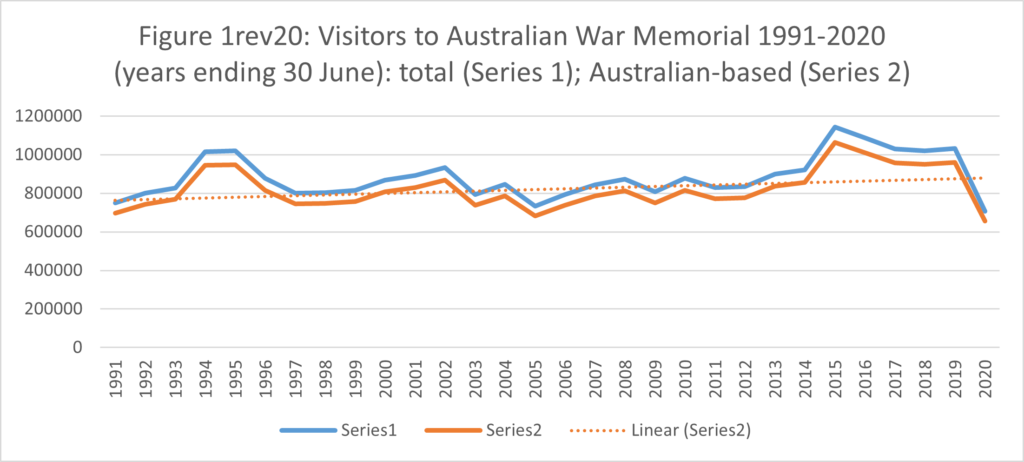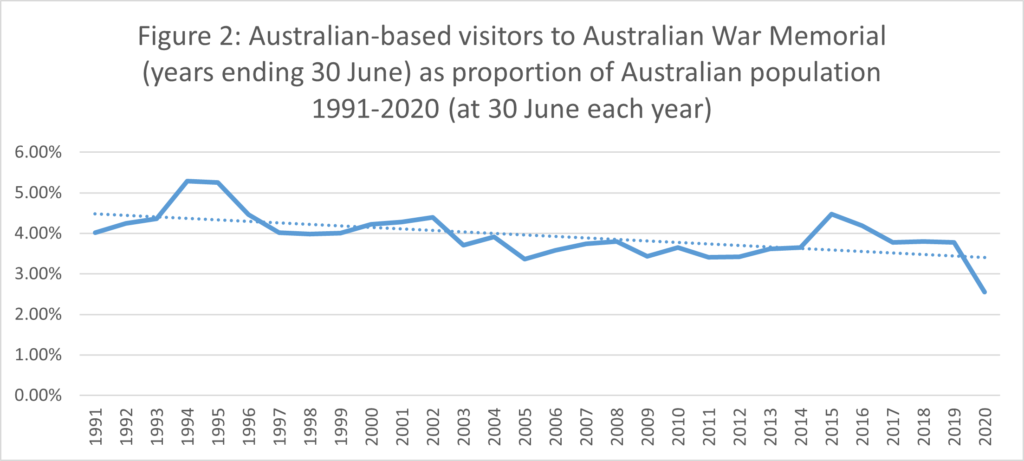‘A wasting asset? War Memorial visitor numbers have been declining – and vainglorious vandalism could make them worse’, Honest History, 23 July 2021 updated
Five years ago, Honest History asked the Australian War Memorial if it kept a historical series of statistics for the number of visitors to the Memorial. It said (implausibly) that it did not, so we compiled our own, using visitor numbers from the Memorial’s annual reports, Australian population statistics, and other numbers. The Memorial (reluctantly) gave us an estimate (seven per cent) for the number of its annual visitors who were not Australian-based, that is, who were tourists from overseas.
We published the results in 2016, 2017 and 2020. The key finding each time was that the number of visitors – the Memorial prefers the term ‘visitation’ – to the Memorial remained pretty much constant as a proportion of Australia’s population: in each year, around four per cent of the national population in that year visited the Memorial – and around 96 per cent did not.
This new post does the numbers for the year 2019-20. It brings the series to exactly 30 years and the result is the same – visitor numbers are not keeping place with population growth. This number is particularly significant as the Memorial starts to destroy itself to make way for its grand new building program: one likely consequence of that vandalism is that visitation numbers will dip during the seven years that construction goes on.
Why is this? First, visitor numbers have already suffered from the effects of bushfires and COVID, with a 44 per cent drop in 2019-20 compared with the previous year, and COVID still a factor in 2020-21. The Memorial redevelopment, long planned, gets under way at a particularly inauspicious time.
Secondly, the Memorial will not be a very attractive tourist destination while the redevelopment work proceeds. Once visitors realise – and they have mostly not been forewarned (there was not a word from the Prime Minister in his Anzac Day address this year) – that Anzac Hall has been demolished and its contents removed, that a massive hole is being dug at the front of the place, that familiar features like the Stone of Remembrance have been moved or boarded up, that more than one hundred trees are being felled – they may well decide not to bother with the Memorial. Or put off their visit to some time in the future.
Put another way, the Memorial may become a wasting asset, a property that has a limited life-span and which loses its value over its life. It may never recover from the combined effects of fire, pestilence, and vainglorious vandalism.
Questions arise. If the Memorial has indeed kept its own figures over these three decades and is aware of the downward trend in visitation, does that explain why its plans for the expanded space emphasise the display of military hardware? As Australia’s demographics change and the older remembrance-focussed clientele stop visiting (and die), will the Memorial need to look more and more like a military Disneyland to continue to attract new generations of Australians through its doors?
Finally, will the Memorial’s Roll of Honour, with its 102 000 names, come increasingly to be seen as a contrast with the redevelopment project, conceived as it was in secrecy, pursued on the basis of faulty arguments and spurious consultation, and threatening to produce a very different institution? Can respectful contemplation exist alongside the ostentatious display of retired military kit? Does the service and sacrifice expressed in the Roll of Honour, all those lives lost defending democracy, lead inevitably to this overblown and boastful project – which is far more a tribute to the powerful men who pushed for it than it is another chapter in what the Memorial’s current spruikers spin as ‘Our Continuing Story’ – or did those 102 000 men and women – and us – deserve something better?
Heritage Guardians, the community campaign, has seen one of its key tasks as recording the history of the Memorial project so that future Australians can see how this all came about. Lest We Forget, indeed.
Thirty years of visitor numbers
In 2016, 2017, and 2020, Honest History took a long view of Australian War Memorial visitor statistics going back to 1990-91. Here, we have updated that analysis using the Memorial’s Annual Report for 2019-20.
The numbers show that any increase in visitor numbers at the Memorial in recent years is not keeping pace with the increase in Australia’s population. In other words, ‘visitation’ to the Memorial is falling in real terms. This has been a trend over 30 years, not just the effect of bushfires and COVID in 2019-20.
A graph summarising the visitation figures for the 30 years, 1990-91 to 2019-20, is below (Figure 1rev20).

In the graph, the blue line (Series 1) is total visitors to the Memorial, ‘through the gate’ at Campbell (including students and including, in some years, a small number of visitors to the Memorial’s premises at Mitchell, but not including visitors to travelling exhibitions). The orange line (Series 2) is total visitors minus seven per cent, which is the Memorial’s 2015 estimate of the proportion of visitors who are tourists and not based in Australia.
So, the orange line is Australian-based visitors and the orange dotted line is the trendline for Australian-based visitors. The trendline is slightly up over the 30 years. The actual figures for Australian-based visitors were 697 500 in 1990-91, 959 440 in 2018-19, and 656 294 in the fire and COVID-affected 2019-20.
What do these figures mean in real terms? The accompanying Excel spreadsheet shows the 30-year average for annual visitors (882 591) and for annual Australian-based visitors (820 804). The most significant figure, however, is Australian-based visitors as a percentage of the total Australian population in a particular year. Figure 2 below shows those figures over the 30-year period.

The Excel spreadsheet shows that Australian-based visitors, as a percentage of the total Australian population, averages over these 30 years at 3.95 per cent. (If we exclude 2019-20 because of the fires and COVID, the average is slightly higher at 3.99 per cent.) Figure 2 shows the trendline is down over the 30 years from about 4.4 per cent to about 3.4 per cent.
Put another way, these 30-year figures show that, if around four per cent of Australians in any one year since 1990-91 visited the Memorial, around 96 per cent in any one year since then did not. Only twice in all those years, in 1994-95 and 1995-96, did more than five per cent of us visit the Memorial.
The Excel spreadsheet also includes statistics for the Memorial’s website and for student visitors (included in the overall visitor numbers). We have not graphed these figures.
Nor have we tried to analyse the Memorial’s figures for ‘first time’ and ‘returning’ visitors. The Memorial’s record-keeping here has been inconsistent and conclusions are hard to draw. It does seem, however, that more than half the Memorial’s visitors in any one year are ‘returning’ – that is, they have been there before. What this means for future numbers is hard to tell: are the returners drawn from a declining, older cohort (in which case they will eventually have to be replaced by first timers if future numbers are to be maintained) or from an emerging, younger cohort (where they may boost future numbers)?
Update 4 November 2021: The Memorial’s Annual Report for 2020-21 is now available and says this about visit figures during 2020-21: ‘COVID-19 had significant impacts on public programs and events, with a large number of visits and programs cancelled. Visitation to the Memorial totalled 311 533, a [further] 44 per cent decrease from 2019–20 numbers’ (page 31 of the pdf). Given the unusual impact of COVID, we have not attempted to update the Excel or graphed figures. But another COVID-affected year reinforces the argument above about the Memorial being a wasting asset: can it recover from the self-inflicted wound of destruction to make way for the redevelopment and from the prolonged effects of the pandemic?
* David Stephens is editor of the Honest History website and has been convener of the Heritage Campaigns campaign against the Memorial project.


Leave a Reply
You must be logged in to post a comment.